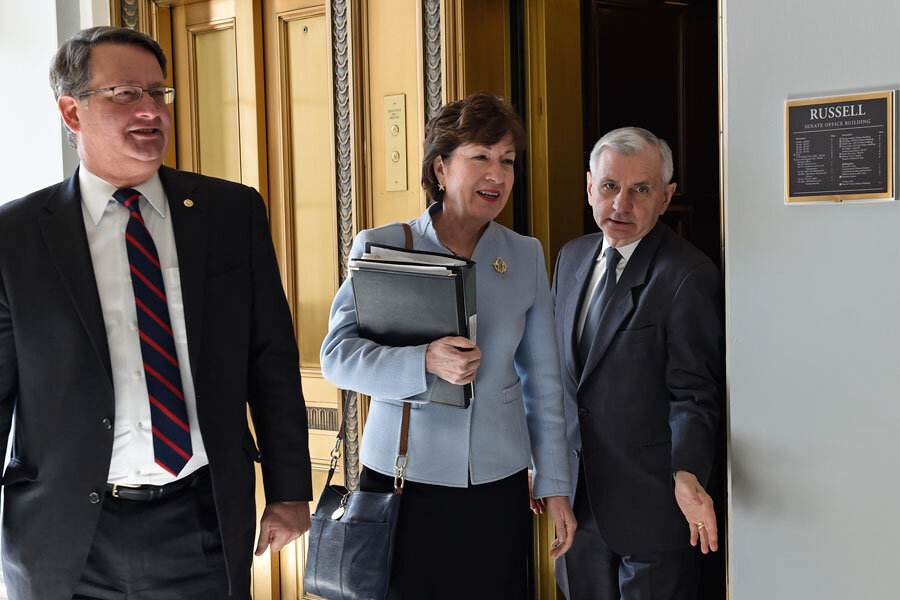Inside Congress's first formal bipartisan luncheon in two years
Loading...
| Washington
When Republican and Democratic senators gathered for a bipartisan luncheon on Wednesday, legislative hot topics were strictly off the table. This was a get-to-know-you, social icebreaker, as the tags labeled “R” and “D” at every other place setting hinted.
The forced integration was meant to help build relationships and break down partisan barriers. And from all accounts, it got the ball rolling.
“I learned something from the other members that I didn’t know,” said Sen. Mark Kirk (R) of Illinois. For example, he had no idea that freshman Sen. Gary Peters (D) of Michigan is a fellow Navy reservist.
“I’m looking forward to [a] partnership, approaching him on the floor and talking to him about that part of his life,” said Senator Kirk.
Even as senators again clashed over immigration and funding for the Department of Homeland Security on Wednesday, they put that aside as they dined among the soaring Corinthian columns of the Kennedy Caucus Room in the Senate Russell Building – site of the famed Watergate hearings. It was the first formal bipartisan luncheon in nearly two years, and planners want to improve on that record, perhaps meeting monthly.
“I think having more social interactions makes it easier for us to work together on legislation,” said Sen. Susan Collins (R) of Maine, who co-hosted the inaugural lunch with Mark Warner (D) of Virginia. Along with the comity, the two made sure to feature fare from their home states: lobster salad and blueberry pie, as well as Virginia ham and biscuits.
At the luncheon, senators had a chance to converse casually with each other. Then they heard stories of “the way things used to be” from senior senators and life stories from three freshmen: Senator Peters and Sens. Shelley Moore Capito (R) of West Virginia and James Lankford (R) of Oklahoma. All three were in the House last year.
“It was wonderful,” said Peters, who sat between Republicans Kelly Ayotte of New Hampshire and Senator Collins. He praised Sen. Patrick Leahy (D) of Vermont, for talking about how to bridge divides. "I think it’s very important for everyone to hear." Sen. Orrin Hatch (R) of Utah spoke of his friendship with the liberal lion, the late Ted Kennedy of Massachusetts, and their trip to historic Faneuil Hall in Boston.
Washington used to be a much more social place for members of Congress. That helped forge friendships – and cooperation – across the aisle. Instead of flying home to their districts on four-day weekends, many lawmakers actually raised their families here. They worked a five-day week, played tennis together, met at parties, and ran into each other at their children’s athletic events.
Now, the House and Senate gyms serve that social function – as does the “Black Tie,” a yacht partially owned by Sen. Joe Manchin (D) of West Virginia. The yacht is given credit as the hatching place for the bipartisan gun background check legislation of 2013. Trap senators in the middle of the Potomac and “good things can happen,” laughs Kirk. (Caveat: the legislation failed).
The luncheons were first suggested by Sens. Jeff Flake (R) of Arizona and Martin Heinrich (D) of New Mexico. After the November elections, they proposed the idea in a letter to the Senate leaders that was signed by 30 of their colleagues, equally split by party.
The two men know each other well. They spent time on an uninhabited island in the South Pacific last year as part of a reality TV special. Most senators don’t have that kind of connection – with nearly half having served four years or less.
“Everybody travels on weekends. You don’t have the opportunity to sit down and actually talk about some of the differences and get to know each other,” said Sen. John Thune, of South Dakota, the No. 3 in Senate Republican leadership, on Tuesday.
Like her colleague from Illinois, Collins, too, was pleased to learn more about newcomer Peters, her table mate. “I had no idea that he has a background in finance, and he worked for Merrill Lynch, and that he ran the lottery in Michigan for a time. I only knew that he’d been a congressman.”
Right away she saw a connection between her work as chairman of the Special Committee on Aging and Peters’s background.
“I talked to him about the hearing that I’m about to chair, because it’s about the financial exploitation of seniors. And I told him I thought he’d be very interested in the aging committee and that I would keep him informed of the work we do in the retirement security area.”
Mission accomplished. For now, anyway.








